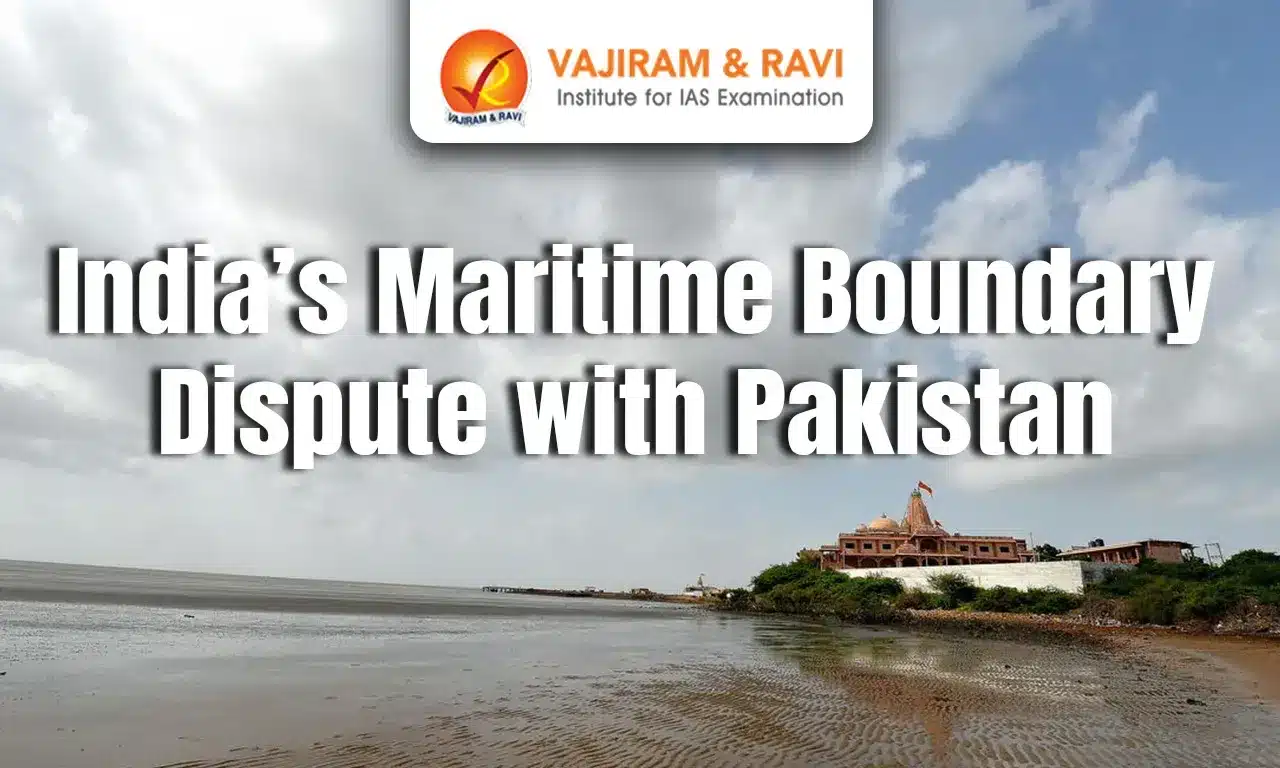What’s in Today’s Article?
- India’s Maritime Boundary Dispute with Pakistan Latest News
- Background – Exclusive Economic Zone (EEZ) and ECS
- India’s Current Oceanic Claims
- Dispute with Pakistan and Sir Creek Issue
- India’s Strategic Response – Modified and Partial Claims
- Overlap with Other Countries – Oman, Myanmar, and Sri Lanka
- India’s Maritime Boundary Dispute with Pakistan FAQs
India’s Maritime Boundary Dispute with Pakistan Latest News
- India has expanded its Extended Continental Shelf (ECS) claim by nearly 10,000 sq km in the Central Arabian Sea.
- India has also modified earlier claims to avoid a long-standing maritime boundary dispute with Pakistan.
- Revised submissions were made in April 2025 to the United Nations’ Commission on the Limits of the Continental Shelf (CLCS).
Background – Exclusive Economic Zone (EEZ) and ECS
- EEZ: Coastal countries have exclusive rights to mining, fishing, and resources up to 200 nautical miles from their baselines.
- ECS:
- Countries can claim additional seabed areas if they can scientifically prove it is a natural extension of their landmass to the CLCS.
- Rights include commercial mining of polymetallic nodules, oil reserves, and other valuable minerals.
India’s Current Oceanic Claims
- 12 nautical miles: Territorial sea.
- 200 nautical miles: EEZ.
- New extension: ~1.2 million sq km of ECS being added to ~2 million sq km EEZ.
- Combined seabed and sub-seabed area: It would become almost equal to India’s land area of 3.274 million sq km.
- India’s first submission to the CLCS: It was made in 2009 covering the Bay of Bengal, Indian Ocean, and Arabian Sea.
Dispute with Pakistan and Sir Creek Issue
- In 2021, Pakistan objected to India’s claims, citing an overlap of 100 nautical miles near the disputed Sir Creek region.
- Sir Creek is a disputed tidal estuary between Rann of Kutch in Gujarat and Sindh province (Pakistan).
- As a result, CLCS rejected India’s full claim in the Arabian Sea in March 2023.
India’s Strategic Response – Modified and Partial Claims
- April 3, 2025: India submitted two partial claims to safeguard uncontested regions.
- This approach avoids weakening India’s position in the valuable Central Arabian Sea region.
- Statement by M Ravichandran [Secretary, Ministry of Earth Sciences (MoES)]: “We have increased our claim by an additional 10,000 sq km based on new data.”
- Institutions of the MoES, such as the National Centre for Polar and Ocean Research (NCPOR, Goa), have played a key role in the technical aspects of determining India’s continental shelf.
Overlap with Other Countries – Oman, Myanmar, and Sri Lanka
- Oman: Overlaps exist but not under dispute due to a 2010 agreement.
- Myanmar and Sri Lanka:
- India’s claims in the Bay of Bengal and Indian Ocean (~300,000 sq km) face objections from Myanmar and Sri Lanka.
- CLCS will begin new consultations later this year on these claims.
India’s Maritime Boundary Dispute with Pakistan FAQs
Q1. What is the significance of India’s extended continental shelf (ECS) claim in the Central Arabian Sea?
Ans. The ECS claim enhances India’s sovereign rights over seabed resources like minerals and hydrocarbons, almost matching India’s land area and strengthening the Blue Economy.
Q2. Why did India modify its original ECS claim in the Arabian Sea recently?
Ans. India modified its claim to avoid overlap with the Pakistan-disputed Sir Creek region, ensuring uncontested areas in the Central Arabian Sea are secured.
Q3. What role does the Commission on the Limits of the Continental Shelf (CLCS) play in maritime boundary claims?
Ans. The CLCS scientifically evaluates and recommends states’ extended continental shelf claims beyond their EEZ based on geological and geomorphological evidence.
Q4. Explain the Sir Creek dispute and its impact on India’s maritime boundary claims.
Ans. The Sir Creek dispute between India and Pakistan over a tidal estuary led to Pakistan’s objection and the CLCS’s rejection of parts of India’s original Arabian Sea claim.
Q5. Name the key institutions involved in supporting India’s technical claims for the extended continental shelf.
Ans. The National Centre for Polar and Ocean Research (NCPOR) and the Ministry of Earth Sciences (MoES) are leading institutions involved in India’s ECS submissions.
Source: TH
Last updated on June, 2025
→ UPSC Notification 2025 was released on 22nd January 2025.
→ UPSC Prelims Result 2025 is out now for the CSE held on 25 May 2025.
→ UPSC Prelims Question Paper 2025 and Unofficial Prelims Answer Key 2025 are available now.
→ UPSC Calendar 2026 is released on 15th May, 2025.
→ The UPSC Vacancy 2025 were released 1129, out of which 979 were for UPSC CSE and remaining 150 are for UPSC IFoS.
→ UPSC Mains 2025 will be conducted on 22nd August 2025.
→ UPSC Prelims 2026 will be conducted on 24th May, 2026 & UPSC Mains 2026 will be conducted on 21st August 2026.
→ The UPSC Selection Process is of 3 stages-Prelims, Mains and Interview.
→ UPSC Result 2024 is released with latest UPSC Marksheet 2024. Check Now!
→ UPSC Toppers List 2024 is released now. Shakti Dubey is UPSC AIR 1 2024 Topper.
→ Also check Best IAS Coaching in Delhi






















